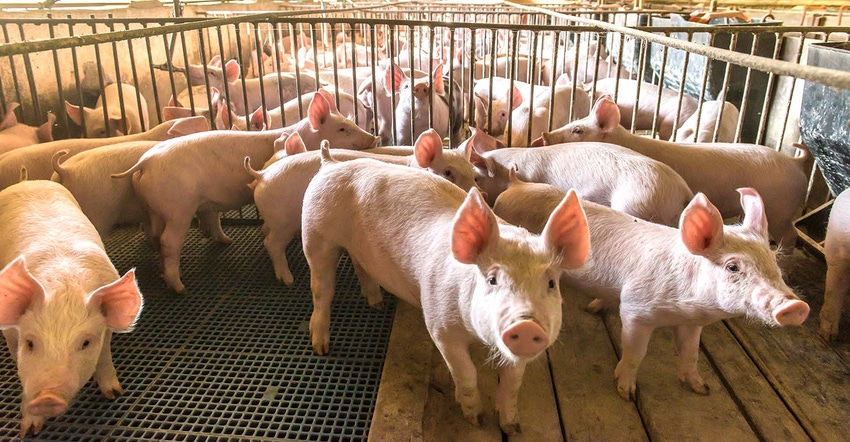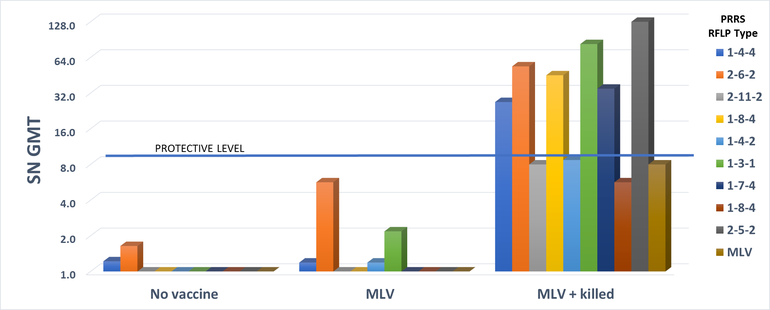A combination approach using both a modified live virus vaccine and an inactivated vaccine is showing promising results against PRRS virus.
October 1, 2019

Sponsored Content
PRRS virus (PRRSV) evolves quickly, making effective vaccination difficult. Multiple studies have shown that neutralizing antibodies are an important factor in controlling disease and a vaccination program should generate an antibody response which is a correlate of protection. Research has shown neither modified live virus nor inactivated vaccines alone sufficiently produce this response¹.
Prime-Boost is a vaccination protocol increasingly being used by researchers and veterinarians. Animals are given a priming dose using a modified live virus vaccine followed by two doses of an inactivated vaccine booster. The theory behind this practice is that the MLV activates both arms of the pigs’ immune system allowing it to robustly respond to inactivated heterologous antigens given in the second dose. As the viruses included in the second booster dose are different than the priming virus, the immune response is broader and recognizes more viral strains.
Researchers at Cambridge Technologies in Worthington, MN, recently tested this protocol in a study, and presented their results at the AASV. Sixty pigs at an integrated sow farm were divided into two groups with ten gilts and twenty multiparous sows per group. The control group received the farm’s standard PRRSV vaccine protocol: two doses of a commercial modified live vaccine (MLV) including the ATP vaccine with the second dose during gilt acclimation. The second group received the same commercial MLV/ATP protocol, but were also re-vaccinated with two doses of an autogenous vaccine administered at nine and thirteen weeks’ gestation. All animals were bled twenty-four hours pre-farrow, and the blood was analyzed for SN titers to seven different PRRSV strains including the autogenous vaccine strain, the MLV strain, the ATP strain, and four heterologous field isolates with different RFLP types.

Laboratory analysis demonstrated a significant increase in neutralizing antibody titers in animals following the prime-boost protocol when compared to those only receiving MLV. The control group showed low SN titers considered to be below the protective level (SN titer <8)² for all but one strain of PRRSV. Conversely, the prime-boost group showed cross-reactive (SN titer>8) neutralizing titers to every PRRSV strain tested.
The results of this study confirmed that administration of an inactivated autogenous PRRS vaccine following administration of an MLV/ATP protocol significantly boosted and broadened the neutralizing antibody response.
A second study using PRRSV seronegative pigs generated similar results. Again, the animals receiving a combination protocol of MLV + inactivated vaccine generated protective SN titers to both the MLV vaccine strain, the homologous inactivated vaccine strain and 7 out of 8 field isolates with heterologous RFLP types while pigs receiving only an MLV did not. The MLV + killed groups also showed a significant reduction in viremia and lung titer when challenged with the homologous killed vaccine strain.
Both of these studies point toward the benefit of a heterologous prime boost program: administration of a MLV “priming” vaccine followed by a whole inactivated virus autogenous booster induces cross-reactive, high titer neutralizing antibodies to a broad range of PRRSV strains. Cambridge Technologies uses Precision Vaccinology® to identify the herd specific isolates to include in a custom inactivated vaccine.
SOURCES
Geldof MF, Vanhee M, Van Breedam W, Van Doorsselaere J, Karniychuk UU, Nauwynck HJ. Comparison of the efficacy of autogenous inactivated porcine reproductive and respiratory syndrome virus (PRRSV) vaccines with that of commercial vaccines against homologous and heterologous challenges. BMC Veterinary Research.2012;8:182.
HanSoo Joo, DVM, PhD; K. Direksin, DVM, MS; Charles Johnson, BS; Won Lee, DVM; Neil DeBuse, DVM. PRRS virus serum neutralizing antibody as a measure of protection. College of Veterinary Medicine, University of Minnesota, St. Paul, MN. 1998 Allen D. Leman Swine Conference
About the Author(s)
You May Also Like



